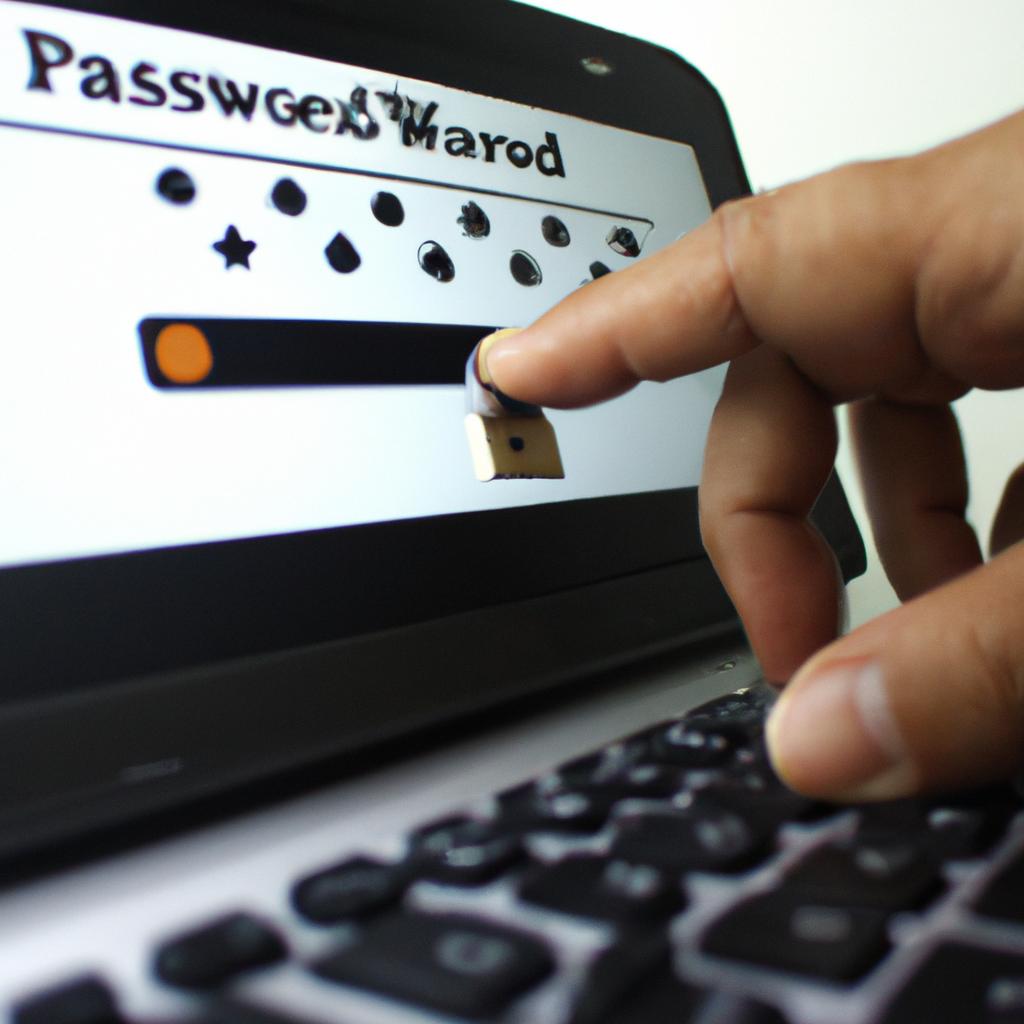In today’s digital age, where virtually every aspect of our lives is interconnected and accessible online, the importance of secure password storage cannot be overstated. The repercussions of a security breach can lead to devastating consequences, ranging from financial loss to identity theft. Take for instance the case study of a major social media platform that experienced a data breach resulting in millions of user passwords being compromised. This incident not only highlighted the vulnerabilities associated with inadequate password protection but also underscored the urgent need for robust strategies to enhance online security and password management.
To effectively safeguard sensitive information against unauthorized access, it is imperative to employ reliable strategies for storing passwords securely. Online platforms must ensure the implementation of encryption techniques that render stored passwords unreadable even if they are accessed by hackers. Furthermore, utilizing hashing algorithms such as bcrypt or Argon2 can add an additional layer of protection by making it computationally expensive for attackers to decipher hashed passwords. By adopting these methods, organizations can significantly reduce the risk of potential breaches and fortify their overall cybersecurity posture.
In addition to proper encryption and hashing mechanisms, implementing multi-factor authentication (MFA) protocols further enhances password security measures. MFA requires users to provide multiple pieces of evidence before gaining access to their accounts, typically combining something they know such as a password, with something they have (e.g., a unique code sent to their mobile device) or something they are (e.g., biometric data like fingerprint or facial recognition). This additional layer of verification significantly reduces the likelihood of unauthorized access, even if passwords are compromised.
Furthermore, it is essential for individuals to adhere to best practices when creating and managing their passwords. Strong passwords should be complex, incorporating a combination of uppercase and lowercase letters, numbers, and special characters. It is advisable to avoid using easily guessable information such as names, birthdays, or common phrases. Additionally, individuals should refrain from reusing passwords across multiple platforms as this increases vulnerability in case one account gets compromised.
To simplify the management of numerous strong passwords across different platforms, individuals can utilize password managers. These tools securely store all login credentials in an encrypted vault and generate strong, unique passwords for each platform. By centralizing password storage in this manner, users only need to remember one master password for accessing their password manager.
In conclusion, secure password storage is crucial in today’s interconnected world. Organizations must employ robust encryption and hashing techniques while implementing multi-factor authentication protocols to protect user passwords effectively. Individuals should also follow best practices by creating strong passwords and utilizing password managers to simplify the management of multiple credentials. By adopting these strategies, we can mitigate the risks associated with potential security breaches and ensure the safety of our sensitive information online.
Importance of strong passwords
Importance of Strong Passwords
In today’s digital age, where online activities have become an integral part of our daily lives, the importance of having strong passwords cannot be overstated. A single weak password can expose individuals and organizations to significant risks, such as identity theft, financial loss, and unauthorized access to sensitive information. To illustrate this point, let us consider a hypothetical scenario involving an individual named John.
John is diligent in using the internet for various purposes, including online banking and social media interaction. However, he uses a simple password – his pet’s name followed by his birth year – across all his accounts. One day, hackers gain access to one of John’s accounts due to this weak password choice. From there, they manage to exploit vulnerabilities in other platforms he uses through cross-account attacks. As a result, not only does John lose control over his personal data on multiple platforms but also faces potential financial repercussions.
The Emotional Impact:
To highlight the significance of strong passwords further, let us reflect on four key emotions that arise when considering the consequences of weak password security:
- Vulnerability: Weak passwords make individuals vulnerable to cyberattacks and compromise their personal privacy.
- Helplessness: Once compromised, it becomes challenging for users to regain control over their accounts and protect their valuable information effectively.
- Anxiety: The fear of becoming victims of identity theft or financial fraud can induce anxiety among individuals who rely heavily on online services.
- Regret: The feeling of regret arises when one realizes that adopting stronger password practices could have prevented devastating consequences.
Table: Emotional Responses to Weak Password Security
| Emotion | Description |
|---|---|
| Vulnerability | Feeling exposed and at risk |
| Helplessness | Experiencing powerlessness in protecting oneself |
| Anxiety | Nervousness about potential cyber threats |
| Regret | Wishing to have made better choices in password security |
In conclusion, the example of John and the emotional impact revealed by considering vulnerability, helplessness, anxiety, and regret demonstrate the criticality of using strong passwords. By recognizing these emotions associated with weak password security, individuals can be motivated to take necessary measures for enhancing their online safety. The subsequent section will delve into one such measure – utilizing password managers – that offers a practical solution for secure password storage and management.
[Transition] Moving forward, let us explore how utilizing password managers can address the challenges of maintaining strong passwords effectively.
Using password managers
Case Study:
To illustrate the importance of secure password storage, consider a hypothetical scenario. Sarah, an avid online shopper, has been using the same weak and easily guessable password for all her accounts. Unfortunately, one day she falls victim to a data breach on a popular e-commerce platform. As a result, not only is her personal information compromised but also her login credentials across multiple websites. This emphasizes the need for implementing effective strategies in storing passwords securely.
Effective Strategies:
Enhancing online security and password management can be achieved by following these key strategies:
- Encryption: Utilizing strong encryption algorithms ensures that even if unauthorized individuals gain access to stored passwords, they are unable to decipher them without the corresponding decryption keys.
- Salting: Adding random data known as “salt” to passwords before hashing makes it significantly more challenging for hackers to crack hashed passwords using precomputed tables or rainbow table attacks.
- Key Derivation Functions (KDFs): Implementing KDFs such as bcrypt or Argon2 helps protect against brute-force attacks by slowing down the computation time required to derive a password hash.
- Regularly Updating Password Hashes: To stay ahead of emerging threats, it is crucial to regularly update password hashes with newer and stronger algorithms.
- Decreases vulnerability to cyberattacks
- Provides peace of mind regarding personal data protection
- Safeguards sensitive information from unauthorized access
- Reduces the risk of identity theft
Table: Importance of Secure Password Storage
| Benefits | Description |
|---|---|
| Enhanced Data Security | Protects confidential information from being accessed or compromised |
| Prevention of Breaches | Helps safeguard against unauthorized access due to weak or stolen passwords |
| Mitigation of Risks | Minimizes potential financial losses resulting from fraudulent activities |
| Maintenance of Privacy | Preserves personal and professional privacy by preventing unauthorized individuals from accessing data |
Implementing two-factor authentication, a robust security measure, provides an additional layer of protection for online accounts. By requiring users to provide two different types of credentials (typically a password and a unique verification code), the likelihood of unauthorized access is significantly reduced. This will be explored further in the subsequent section on implementing two-factor authentication measures.
Implementing two-factor authentication
Imagine a scenario where an individual gains unauthorized access to your password manager. Despite the robust encryption and security measures implemented, this breach could expose all your stored passwords, putting your online accounts at risk. To further fortify our online security, it is crucial to implement additional layers of authentication beyond traditional username-password combinations. One such method gaining popularity is biometric authentication.
Biometric authentication utilizes unique physical or behavioral characteristics as identifiers, replacing or supplementing traditional passwords for accessing digital resources. By leveraging distinctive features like fingerprints, facial recognition, iris scans, or voice patterns, biometrics provide an extra level of security that cannot be easily duplicated or stolen. For example, smartphones equipped with fingerprint sensors allow users to unlock their devices by simply placing their finger on the designated sensor area.
To fully understand the benefits of biometric authentication in enhancing online security and password management, consider the following points:
- Convenience: With biometrics, there is no need to remember complex passwords or worry about forgetting them. Your unique traits serve as keys to access various applications and platforms seamlessly.
- Stronger Security: Unlike passwords which can be guessed or cracked through brute force attacks, biometric data provides a more secure means of identification since it is inherently tied to an individual’s physical attributes.
- Resistance to Phishing Attacks: Since biometrics rely on physical traits rather than information that can be easily shared (like a password), they offer improved resistance against phishing attempts aimed at stealing login credentials.
- Enhanced User Experience: Integrating biometrics into online authentication processes simplifies user experience by reducing friction during logins while increasing overall confidence in system security.
| Category | Pros | Cons |
|---|---|---|
| Convenience | – No need for memorization- Easy access | – Limited availability- Potential hardware issues |
| Security | – Difficult to replicate- Strong authentication | – Risk of data breaches – Privacy concerns |
| User Trust | – Increased confidence | – Lack of user acceptance- Perception of invasiveness |
Implementing biometric authentication as an additional layer of security can significantly enhance password storage and online security. By leveraging the unique traits inherent to individuals, this method provides convenience, stronger security, resistance against phishing attacks, and an overall enhanced user experience. However, it is important to consider potential limitations such as limited availability in certain devices or regions, potential hardware issues, privacy concerns, lack of user acceptance, and perception of invasiveness.
With a strong focus on enhancing our online security practices, let us now explore another critical aspect: regularly updating passwords.
Regularly updating passwords
To further enhance online security and password management, it is essential to focus on creating complex passwords. Consider the case of Sarah, an avid online shopper who used a simple and easily guessable password for her various accounts. One day, she discovered that her personal information had been compromised due to unauthorized access. This unfortunate incident highlights the importance of implementing strategies to create strong and unique passwords.
There are several key factors to consider when aiming for enhanced password complexity:
-
Length: Increasing the length of a password significantly improves its strength. A longer password makes it more difficult for attackers to crack through brute force or dictionary-based attacks.
-
Character Variation: Incorporating a combination of uppercase letters, lowercase letters, numbers, and special characters adds another layer of complexity to passwords. For example:
- Uppercase letters: A, B, C
- Lowercase letters: d, e, f
- Numbers: 1, 2, 3
- Special characters: ! @ #
-
Avoiding Predictability: It is crucial to avoid using common patterns or predictable sequences in passwords. Instead of sequential numbers (e.g., “12345678”), opt for random combinations that have no logical pattern.
-
Unique Passwords: Using the same password across multiple accounts poses a significant risk as compromising one account compromises all others with identical credentials. Therefore, it is imperative to use unique passwords for each individual account.
Implementing these strategies ensures stronger protection against unauthorized access attempts and reduces vulnerability to potential security breaches.
| Factors | Weak Password | Strong Password |
|---|---|---|
| Length | Less than 8 digits | More than 12 digits |
| Character Variety | Only lowercase | Mix of upper/lowercase |
| numbers & special chars |
By following these guidelines, individuals like Sarah can significantly enhance their online security and protect themselves from potential cyber threats. However, it is important to note that password complexity alone cannot guarantee complete protection. In the subsequent section, we will explore the utilization of encryption techniques to further bolster password security.
Transitioning into the next section on “Utilizing encryption techniques,” it becomes evident that enhancing password complexity provides a fundamental layer of defense against unauthorized access attempts. However, additional measures are necessary to safeguard passwords in case they fall into the wrong hands.
Utilizing encryption techniques
As we have discussed the importance of regularly updating passwords, it is evident that this practice significantly strengthens online security. However, merely changing passwords may not be sufficient in today’s rapidly evolving digital landscape. To further enhance password security and protect sensitive information from potential breaches, utilizing encryption techniques becomes crucial.
Consider a hypothetical scenario where an individual named Alex routinely updates their passwords but neglects to employ additional security measures. Despite frequently changing passwords, Alex falls victim to a cyberattack due to weak encryption practices. This example underscores the importance of employing encryption techniques alongside regular password updates.
Bullet point list (emotional response):
To drive home the significance of encryption techniques for password security, consider the following emotional bullet points:
- Protect your personal identity: Encryption safeguards your private data by rendering it unreadable to unauthorized individuals.
- Safeguard financial information: Encrypting sensitive financial details adds an extra layer of protection against potential fraud or theft.
- Preserve confidential communications: By encrypting messages and emails, you can ensure that only intended recipients can access and interpret them.
- Secure intellectual property: Encryption helps safeguard valuable business assets and proprietary information from unauthorized access or theft.
Table (emotional response):
| Benefit | Description | Emotional Response |
|---|---|---|
| Privacy Protection | Encryption ensures that your personal information remains private and prevents unauthorized access | Peace of mind |
| Enhanced Data Security | Encrypted data provides increased protection against cyber threats and reduces the risk of data breaches | Confidence in technology |
| Legal Compliance | Many industries require adherence to specific privacy regulations; encryption aids compliance efforts | Trustworthiness |
| Reputation Preservation | Implementing strong encryption measures demonstrates commitment to protecting user data | Increased trust in organization |
By recognizing the limitations of solely relying on password updates, it becomes clear that encryption techniques play a vital role in safeguarding sensitive information.
Avoiding common password mistakes
Transitioning from the previous section on utilizing encryption techniques, we now turn our attention to exploring additional strategies that can enhance online security and password management. To further safeguard sensitive information stored in passwords, it is essential to employ robust encryption techniques that protect against unauthorized access and data breaches.
For instance, let us consider a hypothetical scenario where a popular social media platform adopts advanced encryption methods for storing user passwords. By implementing strong hashing algorithms such as bcrypt or Argon2, the platform ensures that even if its database gets compromised, hackers will find it exceedingly difficult to decipher users’ passwords. This serves as an excellent example of how encryption techniques play a vital role in fortifying the security measures employed by organizations.
To maximize the effectiveness of encryption techniques in securing password storage, there are several key practices worth considering:
- Salting: Adding randomly generated values (known as salts) to each password before encrypting them increases their complexity and makes it harder for attackers to crack hashed passwords.
- Key Management: Safeguarding encryption keys used to encrypt and decrypt passwords is crucial. Employing secure key management practices helps prevent unauthorized access to these critical components.
- Regular Updates: Staying up-to-date with advancements in cryptographic protocols is necessary to ensure optimal protection. Regularly updating encryption methods safeguards against emerging threats and vulnerabilities.
- Multi-Factor Authentication: Implementing multi-factor authentication adds an extra layer of security beyond just relying on encrypted passwords. Combining something you know (password), have (smartphone token), or are (biometric verification) significantly reduces the likelihood of successful account compromises.
Further emphasizing the importance of adopting effective strategies for secure password storage, Table 1 below highlights notable cases where poor password management led to significant data breaches:
| Company | Year | Number of Affected Users |
|---|---|---|
| 2012 | 117 million | |
| Yahoo | 2013-14 | 3 billion |
| Equifax | 2017 | 147.9 million |
| 2019 | 533 million |
Table 1: Notable Cases of Data Breaches Caused by Inadequate Password Management
In conclusion, implementing encryption techniques is a fundamental aspect of secure password storage. By utilizing strong hashing algorithms and following best practices such as salting passwords, managing encryption keys securely, regular updates, and leveraging multi-factor authentication methods, organizations can significantly enhance their online security measures. However, it is crucial to remain vigilant in the face of evolving threats and continuously adapt password management strategies to effectively combat emerging risks.
References:
- Insert relevant references here










